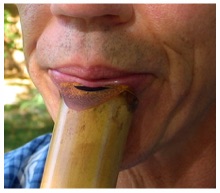
Initial positioning for blowing the first notes
There are three postural components to put in place when blowing the first sounds:
1. Good upright torso, neck and head alignment
2. Correct position of the back of the shakuhachi below the bottom lip.
3. The angle of inclination of the flute.
1) Whichever playing position you take, ensure that you are truly vertical all the way up to the top of your head. A mirror can help with this positioning. A common mistake is to allow the head to fall forward from the neck.
2) The back of the shakuhachi is positioned so that the utaguchi blowing edge situates itself just above the bottom lip, leaving a gap of about 2mm or less. This necessitates sliding the back of the flute up and down the chin carefully until that position is found. The flute does not necessarily fit best in the natural cavity under the bottom lip. Flicking out the tongue to touch the sharp top of the utaguchi is a great way to establish the geography of positioning. The tongue can be a reliable help to ensure you have a good position before blowing.
3) The partner to position 2 is the angle of the flute....this angle helps to create the right gap between the bottom lip and the utaguchi edge. For many players, 45 degrees is fine, but small angle adjustments may have to be made for the best positioning.
Once these three postural aspects are in place, they can remain as they are. They don't need to vary as you play. From this point onwards, it is the lips (in particular the top lip) that does the necessary work for embouchure shaping.
How to blow shakuhahchi
A good utilitarian embouchure often has two properties: the top lip sits slightly forward of the bottom lip and the aperture between the lips is a flattened horizontal narrow slot.
By using a trifold mirror, like a bathroom mirror, you can observe these two parameters and adjust accordingly.
Begin by blowing gently across the utaguchi cut edge, as though you are cooling a cup of hot tea. Try not to form a round hole between your lips. Aim for a more flattened slot instead. There is a point at which you'll find a 'sweet spot' where the sound suddenly emerges strongly and clearly. The first mistake most people make is to blow too strongly, and then to blow even more when no sound emerges!
Not much effort is required to create a small flattened nozzle between the lips. A slight tensioning of the muscles at the sides of the mouth will flatten the gap between the lips.
The tongue is quite relaxed, floating in the lower basin of the mouth cavity, but the end of the tongue anchors itself on the gum line below the bottom front teeth. There are variations on this anchor point.
Limit the amount of movement you go through (with flute and lips) to find a sound. Shakuhachi tonal and pitch modulation takes place in a physical micro arena. Stillness (not rigidity) is necessary to maintain a clear strong tone. Very tiny lip and chin movements can result in a big effect on the quality of the tone.
Breathing
Contrary to intuition, one does not need a lot of breath to play shakuhachi. Some older and very famous players have only one lung, but they still can play with full power and control.
Breathing begins and ends at the 'hara', the abdominal muscle wall area around the belly button. Breathe in by allowing the abdominal wall to relax gently outwards.
The exhalation of the breathe through the flute can be visualized as a soft wind sourced deep inside your lower abdomen, and released into sound.
Long tones
Spend a good amount of time just blowing long tones, each one a complete slow exhalation, after a deep inhalation. It's better to exhale slowly, and as you do this, adjust your lips with small movements until a sound is created. This is a more reliable method than lunging at the flute with repeated quick breaths.
The second and third octaves
The higher octaves require an increase in air pressure in the bore of the flute. The interesting thing about this is that one needs almost no effort to make that happen. A combination of a slightly flatter lip opening and a slightly closer positioning of the lips to the utaguchi cut edge, will speed the air up sufficiently to kick the sound into the second octave. This is SUBTLE. No efforting is needed! If you watch a player do this, you will hardly notice any difference in blowing and embouchure from the lower octave to the upper octave. The better and stronger your lower octave sound is, the better and easier it will be to access your upper octave sound.
If you are making a huge effort in order to blow the second octave, catch yourself, and remember success comes with embouchure shaping, not blowing harder. Try to flatten the slot between your lips by bringing the top lip down closer to the bottom lip.
Tonal tweaking
Flattening and narrowing the lip aperture will produce a purer sound. Loosen the embouchure and soften the lips and the sound becomes 'looser', with more breathy overtones. An experienced player will be able to create a solid tonal 'core, around which play beautiful harmonics. There is incredible subtlety in embouchure technique. It's not haphazard. The player is fully in control all the time.
If you can, find a teacher
As with any musical instrument, formal study will open up your awareness and develop your creative options.
The most startling experience you can have as a new student is to have your teacher play your own flute. Then you realize how much more music can come from study.
Most classical Japanese music can only come to a student via transmission from a teacher. There is so much subtlety involved in the playing of honkyoku solo pieces, for example, that they can only be notated roughly. The music is demonstrated and transmitted by the teacher and student playing together.


Shakuhachi for sale